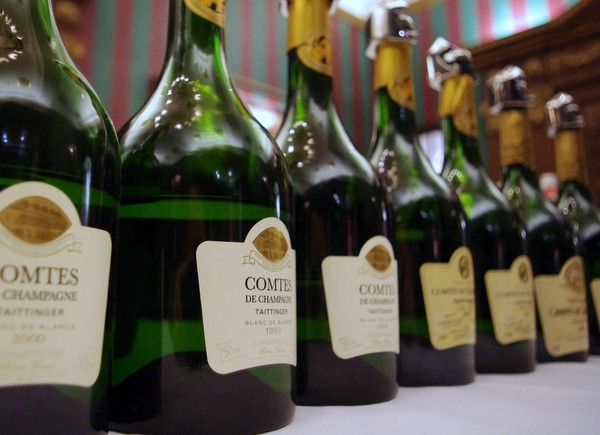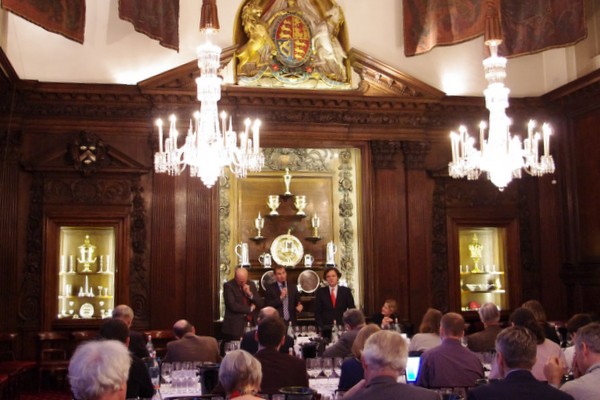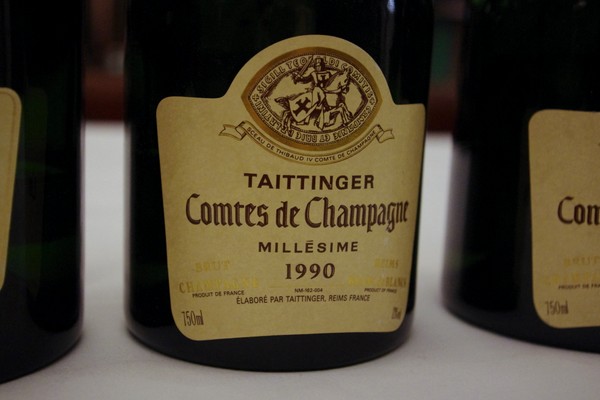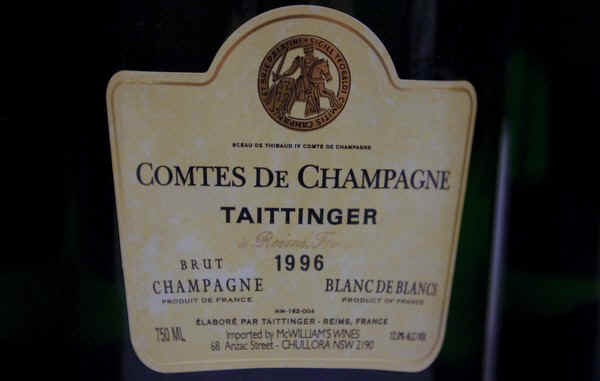|
Taittinger
Comtes de Champagne
A vertical tasting of this remarkable prestige Blanc de Blancs
Champagne

I love vertical tastings. Trying a range
of different vintages of the same wine side by side is hugely
educational. And when it’s a wine such as Taittinger’s Comte de
Champagne—their prestige cuvée
Blanc de Blancs—they are also tremendous fun. This tasting was
hosted by Pierre Emmanuel Taittinger, chef du cave Loic Dupont and
production manager Damien Le Sueur.
‘There are two categories of
cellarmasters,’ claims Pierre-Emmanuel, as he introduced
Taittinger chef du cave Loic Du Pont. ‘Those who travel and those
who stay in the cellar.’ Loic falls into the latter category, and
never travels, says Pierre Emmanuel.
‘Loic is always in Reims. Our cellars
were the cellars of monks, and we behave like monks: it is a small
team but we try to maintain the atmosphere of a
monastery—generosity, soul and friendship. Our walls and cellars
influence us to keep this soul.’ Loic du Pont has been at
Taittinger for 26 years now.

But most of the chat, and there was quite
a bit of it, came from consummate marketer Pierre-Emmanuel
Taittinger. ‘I have drunk at least 1.5 bottles per day for 30
years,’ he states, which indicates a healthy constitution.
[Perhaps the most perplexing of his comments was the statement,
‘Champagne is not French.’ I can guess at what he means by this,
but I’m not totally sure.]
We began the tasting by looking at the
current release of Taittinger’s NV, which is 40% Chardonnay, 35%
Pinot Noir and 25% Pinot Meunier. Reserve wine is 3 year old wine
from vats and makes 25–30% of the blend. The origin of the crus
varies quite a bit from year to year, and there is a minimum of
three years before disgorgement. Typically there are 40 different
crus in the wine. ‘It is the flagship of the house,’ says Pierre
Emmanuel, ‘the first cuvée
we work with.’

‘We have considerable stock in the
company,’ says Pierre Emmanuel. ‘When I bought back Taittinger
with help from Crédit Agricole in 2006 [the company had been sold
in 2005] they said they wanted me to keep the brand at the top of
the quality level. They have permitted us to develop the quality of
the company.’
Production is 5 million bottles annually,
and with 288 hectares of vineyards they have enough for around half
their needs. ‘It is a great asset for Taittinger to have such
beautiful vineyards,’ says Pierre Emmanuel, who reports that the
going rate for a hectare of vines in the Côtes
de Bar is 1.8 million Euros. This hectare would make around 10 000
bottles. Champagne as a region is 33 000 hectares and all the
vineyards are planted; there is big competition for grapes.
‘In 1939 the total sales of Champagne
were 10 million bottles,’ says Pierre Emmanuel. ‘Now there are
320 million bottles produced annually, with fewer vineyards than
before. The improvement in viticulture and winemaking has achieved
this.’
Pierre Emmanuel also mentioned the change
in market conditions. ‘Three years ago, 90% of Champagne went to
USA and Europe. Now Asia, South America and Russia are important
markets. We are entering a new world of Champagne.’
What about climate change and Champagne?
‘I am anxious about global warming in the long-term, but over the
last 10 years it has been excellent for Champagne production,’ he
says. ‘Globally, the quality of NV has risen. Sometimes our NV is
of vintage quality.’
‘Champagne is 10 times better than it
was 30 or 40 years ago.’
And disgorgement dates? ‘I am totally
against putting the date of disgorgement on the wine,’ states
Pierre Emmanuel. ‘If we put RD on the bottle but don’t sell it
quickly it is not RD. If it stays for 5 years in the cellars of Le
Gavroche then it is no longer RD and we are lying to our customers.
The quality of Champagne has nothing to do with a date.’
‘We see people who put disgorgement
dates on NV bottles, but the most important thing is the time on the
lees,’ says Damien Le Sueur. ‘We give the professional customers
this information—it is not a secret—but we think it is too
complicated for customers to understand.’

Comtes de Champagne comes from five grand
crus, and is not made every vintage. It is matured for 8–10 years.
The largest production was in 1995 with 500 000 bottles; normally it
is 150–300 000. Pierre Emmanuel says that he prefers to drink it
with bottle age, and this is why it isn’t kept for late
disgorging. He thinks it peaks after 15 years.
These wines showed brilliantly. The only
slightly controversial wine was the 1990, which was markedly more
developed than the others. Some liked it; others didn’t.
THE
WINES
Champagne Taittinger Comtes de
Champagne Blanc de Blancs 2002
First pressings only. 5% matured in new French oak. 100% malolactic,
10 years on lees. Fine, restrained toast and citrus nose. Complex,
powerful palate with ripe fruits, nuts and citrus, as well as some
herbiness. Fine structure and good acidity. Very attractive
toastiness here, accompanying the ripe citrus and white peach fruit.
Hints of vanilla. A lovely wine. 94/100
Champagne Taittinger Comtes de
Champagne Blanc de Blancs 2000
First pressings only. 5% matured in new French oak. 100%
malolactic, 10 years on lees; this has been disgorged for 6 months.
Very rich, aromatic and fine with sweet toasty notes on the nose as
well as almonds, vanilla and lemony fruit. The palate is bold,
toasty and fine with attractive ripe, broad fruit. Still focused,
though. Nicely toasty and really attractive with good structure.
Showing lovely purity and notes of peach, pear, citrus and toast.
95/100
Champagne Taittinger Comtes de
Champagne Blanc de Blancs 1999
First pressings only. 5% matured in new French oak. 100%
malolactic, 9 years on lees; this has been disgorged for 1.5 years.
1999 saw the lowest acidity for 50 years. Fine bready, toasty nose
with some warmth and also clean citrus fruits. Very fruity. The
palate is fresh, fine and crisp with citrus fruit and some herby
notes. Lovely precision and finesse here. Fine, with delicious
citrus and toast notes. 93/100
Champagne Taittinger Comtes de
Champagne Blanc de Blancs 1998
First pressings only. 5% matured in new French oak. 100%
malolactic, 8 years on lees. Taut, toasty, aromatic nose. The palate
is fresh with lemony fruit and some toastiness. Quite structured and
warm with some savoury bite. Rich hazelnut, peach and pear notes yet
with bracing lemony acidity. Vinous with nice freshness and some
slightly reductive savoury characters on the finish. Lovely
precision. 94/100
Champagne Taittinger Comtes de
Champagne Blanc de Blancs 1996
You have to go back to 1928 to find such a balance of ripeness
with high acidity: 10 g/l acidity and 10 degrees of potential
alcohol at harvest. First pressings only. 5% matured in new French
oak. 100% malolactic, 10 years on lees. Amazingly fine, complex,
bold nose showing savoury, toasty notes and hints of wax and herbs.
The palate is powerful with high acidity and firm, savoury, toasty
characters, as well as fresh citrus and pear fruit. There’s a
boldly savoury character here. Waxy, herby, a little reductive and
showing a hint of coffee. Remarkable wine with great potential.
96/100
Champagne Taittinger Comtes de
Champagne Blanc de Blancs 1995
First pressings, 5% of blend matured in new French oak, 5 years
on lees, full malo. Lovely aromatic, toasty nose is warm, bready and
fine with some peach and pear richness. Complex and fresh. The
palate is fresh with lively lemony acidity and lovely toastiness.
Notes of nuts, bread, honey and peach. Structured, linear and pure
with real finesse. 96/100
Champagne Taittinger Comtes de
Champagne Blanc de Blancs 1990
Golden colour. Quite sweet on the nose with some apricot
character, almost like a Sauternes. Aromatic and toasty with apples,
straw, honey and citrus. The palate is evolved and nutty with citrus
and toast. An oxidative style with maturity, depth and power, as
well as almonds and apricots. Quite different to the other wines,
but lovely with it. Some will find this too developed. 96/100
See
also:
 Champagne
Philipponnat Champagne
Philipponnat
 Krug Krug
Wines
tasted 12/11
Find these wines with wine-searcher.com
Back
to top
|

